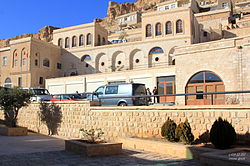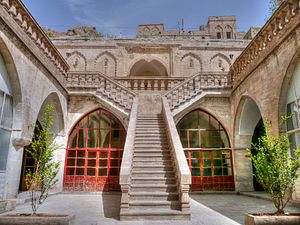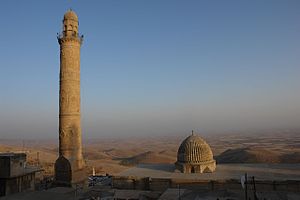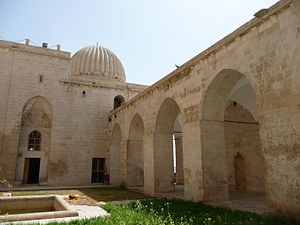Mardin (Kurdish: Mêrdîn, Syriac: ܡܶܪܕܺܝܢ, Arabic/Ottoman Turkish: ماردين Mārdīn, Template:Lang-arm) is a city in southeastern Turkey. The capital of Mardin Province, it is known for the Artuqid (Artıklı or Artuklu in Turkish) architecture of its old city, and for its strategic location on a rocky hill near the Tigris River that rises steeply over the flat plains.[2]
History
Antiquity
The territory of Mardin and Karaca Dağ was known as Izalla in the Late Bronze Age (variously: KURAzalzi, KURAzalli, KURIzalla), a Hurrian kingdom first mentioned during the reign of Tukulti-Ninurta I, c. 1230 BC).[citation needed] The ciry was absorbed into Assyria during the Middle Assyrian Empire (1365-1020 BC), and then again during the Neo Assyrian Empire (911-605 BC).[3]
The ancient name was rendered as Izalā in Old Persian and it survived into the Assyrian Christian period as the name of Mt. Izala (Izla), on which in the early 4th century AD stood the monastery of Nisibis, housing seventy monks.[4]
In the Roman period, the city itself was known as Marida (Merida),[5] supposedly from a Syriac-Assyrian name translating to "fortress".[6][7] The bishopric of the Assyrian Church of the East that was centred on the town when it was part of the Roman province of Osrhoene (a former Neo Assyrian kingdom) became part of the Catholic Church in the late 17th century AD, and is still included in the Catholic Church's list of titular sees under the ancient name of the town.[8] It was a suffragan see of Edessa, the province's metropolitan see.
Medieval history
Byzantine Izala fell to the Seljuks in the 11th century. During the Artukid period, many of Mardin's historic buildings were constructed, including several Mosques, Palaces, Madrassas and Hans.[citation needed] Mardin served as the capital of one of the two Artukid branches during the 11th and 12th centuries. The lands of the Artukid dynasty fell to the Mongol invasion sometime between 1235 and 1243, but the Artukids continued to govern as vassals of the Mongol Empire.[9] During the battle of Ain Jalut in 1260, the Artukid governor revolted against Mongol rule. Hulegu's general and Chupan's ancestor, Koke-Ilge of the Jalayir, stormed the city and Hulegu appointed the rebel's son, al-Nasir, governor of Mardin. Although, Hulegu suspected the latter's loyalty for a while, thereafter the Artukids remained loyal unlike nomadic Bedoun and Kurd tribes in the south western frontier. The Mongol Ilkhanids considered them important allies. For this loyalty they shown, Artukids were given more lands in 1298 and 1304.[citation needed] Mardin later passed to the Akkoyunlu, a federation of Turkic tribes that controlled territory all the way to the Caspian Sea.
During the medieval period, the town became the centre for episcopal sees of Armenian and Assyrian-Syriac Christians. For instance, the Chaldean diocese seems to have been founded in the second half of the 16th century after breaking from the Assyrian Church of the East.[10]
Modern history
Template:Historical populations
In 1517, Mardin was annexed by the Ottomans under Selim the Grim. During this time, Mardin was administered by a governor directly appointed under the Ottoman Sultan's authority. In 1923, with the founding of the Republic of Turkey, Mardin was made the administrative capital of a province named after it.
During World War I Mardin, among other regions close by was one of the sites affected by the Assyrian Genocide and Armenian Genocide.
Geology
During the late Permian ~250 mya the Afro-Arabian plate started opening up. The East African continental rift initiation is believed to have started around 27-31 million years ago with the beginning of the basaltic volcanism of the Afar Plume. This rift system would cause a contractional tectonic process to occur in which the Arabian Plate was pushed in a north-easterly direction towards the Eurasian plate. The divergence in the East African Rift would eventually cause the closure of the Tethys Ocean as the Arabian Plate made its first inception of collision with Eurasia between 25-23 million years ago, and complete closure around 10 mya and creation of the Mardin High.
Historical landmarks
Mardin has often been considered an open air museum due to its historical architecture. Most buildings use the beige colored limestone rock which has been mined for centuries in quarries around the area. The whole city has been listed by UNESCO as a World Heritage Site under the "Mardin Cultural Landscape".
Churches
- Meryemana (Virgin Mary) Church
- Mor Yusuf (Surp Hovsep; St Joseph) Church
- Mor Behnam (Kırk Şehitler) Church - built in the name of Mor Behnam and Mort Saro, the son and daughter of a ruler; dates back to 569 AD
- Deyrü'z-Zafaran Monastery - The Syriac Orthodox Saffron Monastery was founded in 439 AD and is one of the oldest monasteries in the world and the only one that is still functioning in southern Turkey. From 1160 until 1932, it was the seat of the Syriac Orthodox Patriarch, until the Patriarchate relocated to the Syrian capital Damascus. The site of the monastery itself is said to have been used as a temple by sun worshipers as long ago as 2000 BCE.[11][12]
- Mor Mihail Church
- Mor Semune Church
- Mor Petrus and Pavlus (SS. Peter and Paul) Church
- Red (Surp Kevork) Church
- Mor Cercis Church
- Mor Efraim Monastery
Mosques
- Great Mosque (Ulu Camii) - constructed in the 12th century by the ruler of the Artukid Turks, Qutb ad-din Ilghazi. It has a ribbed dome and a minaret that soars above the city. There were originally two minarets, but one collapsed many centuries ago.
- Melik Mahmut Mosque - built in the 14th century and contains the tomb of its patron Melik Mahmut. It is known for its large gate which features elaborate stonework.
- Abdüllatif Mosque (Latfiye Mosque) - built in 1371 by the Artukid ruler Abdüllatif. Its minaret was destroyed by Tamerlane's army and rebuilt many centuries later in 1845 by the Ottoman Governor Gürcü Mehmet Pasha.
- Şehidiye Medresse and Mosque - built in 1214 by Artuk Aslan. It has an elaborate ribbed minaret and an adjoining madrassa.
- Selsel Mosque
- Necmettin Gazi Mosque
- Kasım Tuğmaner Mosque
- Reyhaniye Mosque - the second largest mosque in Mardin after Ulu Camii. Built in the 15th century, it has a large courtyard and open hallway featuring a fountain.
- Hamidiye Mosque (Zebuni Mosque) - built before the 15th century, it is named after its patron Şeyh Hamit Effendi.
- Süleymanpaşa Mosque
- Secaattin and Mehmet Mosque
- Hamza-i Kebir Mosque
- Şeyh Abdülaziz Mosque
- Melik Eminettin el-Emin Mosque
- Sıtra Zaviye Mosque
- Şeyh Salih Mosque
- Mahmut Türki Mosque
- Sarı Mosque
- Şeyh Çabuk Mosque - built in the 14th century and contains the tomb of its patron Şeyh Çabuk
- Nizamettin Begaz Mosque
- Kale Mosque
- Dinari Mosque
Madrassas
- Zinciriye Medrese (Sultan Isa Medrese) - constructed in 1385 by Najm ad-din Isa. The madrasa is part of a complez that includes a mosque and the tomb of Najm ad-din Isa.
- Sitti Radviyye Medrese (Hatuniye Medrese) - built in the 12th century in the honor of Sitti Radviyye, the wife of Najm ad-din Alpi. There is a footprint that is claimed to be that to be that of the Prophet Muhammad.
- Kasımiye Medrese - construction started by the Artukids and completed by the Akkoyunlu under Sultan Kasım. It has an adjoining Mosque and a Dervish lodge.
Climate
Mardin has a Mediterranean climate with hot, dry summers and cold, wet, and occasionally snowy winters. Temperatures in summer usually increase to 40 °C (104 °F) due to Mardin being situated right next to the border of Syria. Snowfall is quite common between the months of December and March, snowing for a week or two. Mardin has over 3000 hours of sun per year. The highest recorded temperature is 42.5 °C (108.5 °F). Average rainfall is about 641.4 mm (25 inches) per year.
Economy
Notable people
- Betül Mardin, businesswoman and activist
- Bülent Tekin, poet and writer
- Masum Türker, former Minister of Finance
- Muammer Güler, governor
- Mümtaz Tahincioğlu, head of TOMSFED
- Murathan Mungan, poet and writer
- Sultan Kösen, the world's tallest living man since 2009, lives in Mardin.[14]
- Zeynel Abidin Erdem, businessman
International relations
Twin towns — Sister cities
Mardin is twinned with:
- Template:Country data SVN Ljubljana, Slovenia, since 2003.[15]
Gallery
See also
References
Cite error: Invalid <references> tag;
parameter "group" is allowed only.
<references />, or <references group="..." />This article includes a list of references, but its sources remain unclear because it has insufficient inline citations. (February 2008) |
- Ayliffe, Rosie, et al.. (2000) The Rough Guide to Turkey. London: Rough Guides.
- Gaunt, David: Massacres, Resistance, Protectors: Muslim-Christian Relations in Eastern Anatolia During World War I, Gorgias Press, Piscataway (NJ) 2006 I
- Grigore, George (2007), L'arabe parlé à Mardin. Monographie d'un parler arabe périphérique. Bucharest: Editura Universitatii din Bucuresti, ISBN (13) 978-973-737-249-9 [1]
- Jastrow, Otto (1969), Arabische Textproben aus Mardin und Asex, in "Zeitschrift der Deutschen Morgenländischen Gesellschaft" (ZDMG) 119 : 29-59.
- Jastrow, Otto (1992), Lehrbuch der Turoyo-Sprache in "Semitica Viva – Series Didactica", Wiesbaden : Otto Harrassowitz.
- Minorsky, V. (1991), Mārdīn, in "The Encyclopaedia of Islam". Leiden: E. J. Brill.
- Niebuhr, Carsten (1778), Reisebeschreibung, Copenhagen, II:391-8
- Shumaysani, Hasan (1987), Madinat Mardin min al-fath al-'arabi ila sanat 1515. Bayrūt: 'Ālam al-kutub.
- Tavernier, Jean-Baptiste (1692), Les six voyages, I:187
- Sasse, Hans-Jürgen (1971), Linguistische Analyse des Arabischen Dialekts der Mhallamīye in der Provinz Mardin (Südossttürkei), Berlin.
- Socin, Albert (1904), Der Arabische Dialekt von Mōsul und Märdīn, Leipzig.
- della Valle, Pietro (1843), Viaggi, Brighton, I: 515
- Wittich, Michaela (2001), Der arabische Dialekt von Azex, Wiesbaden: Harrassowitz.
External links
| Wikimedia Commons has media related to Mardin. |
- The Spoken Arabic of Mardin
- Mardin Weather Forecast Information
- Mardin Guide and Photo Album
- First International Symposium of Mardin History
 "Mardin". Catholic Encyclopedia. New York: Robert Appleton Company. 1913.
"Mardin". Catholic Encyclopedia. New York: Robert Appleton Company. 1913.
Template:Metropolitan municipalities in Turkey
Template:Tentative list of World Heritage Sites in Turkey- ↑ http://www.al-monitor.com/pulse/originals/2014/04/christian-mayor-turkey-rights-bdp-mardin.html
- ↑ [2], from roughguides.com
- ↑ Parpola - Assyrians after Assyria
- ↑ Johann Elieser Theodor Wiltsch, trans. John Leitch, Handbook of the Geography and Statistics of the Church, Volume 1, Bosworth & Harrison, 1859, [books.google.ch/books?id=DbwpAAAAYAAJ&pg=PA232 p. 232.]
- ↑ Encyclopædia Britannica, entry: Mardin. Retrieved January 2014 Fraternité Chrétienne Sarthe-Orient, "Marida (Mardin)"
- ↑ Lipiński, Edward (2000). The Aramaeans: their ancient history, culture, religion. Peeters Publishers. p. 146. ISBN 978-90-429-0859-8.
- ↑ Smith, of R. Payne Smith. Ed. by J. Payne (1998). A compendious Syriac dictionary : founded upon the Thesaurus Syriacus (Repr. ed.). Winona Lake, Ind.: Eisenbrauns. p. 299. ISBN 978-1-57506-032-3. Retrieved 8 March 2013. suggesting Mardin as a plural "fortresses".
- ↑ Annuario Pontificio 2013 (Libreria Editrice, 2013, ISBN 978-88-209-9070-1), p. 923
- ↑ Ed. Morris Rossabi - China among equals: the Middle Kingdom and its neighbors, 10th-14th centuries, p. 244
- ↑ These sees also appear, not under the ancient name but under the modern name of Mardin, in the Catholic Church's list of titular sees. The titular sees of the Armenian and the Syriac Christians are of archiepiscopal rank, see Annuario Pontificio 2013 (Libreria Editrice, 2013, ISBN 978-88-209-9070-1), p. 923.
- ↑ SOR (2000-04-19). "Dayro d-Mor Hananyo: Erstwhile seat of the Syriac Orthodox Patriarch". Sor.cua.edu. Retrieved 2012-08-17.
- ↑ "ARTS-CULTURE - Syriac monastery dated back to 4,000 years". Hurriyetdailynews.com. 2010-01-03. Retrieved 2012-08-17.
- ↑ Prothero, W.G. (1920). Armenia and Kurdistan. London: H.M. Stationery Office. p. 62.
- ↑ Satter, Raphael (16 Sept 09). "8'1" Turk takes title of world's tallest man". Retrieved 17 Sept 09. Check date values in:
|access-date=, |date=(help) - ↑ "Medmestno in mednarodno sodelovanje". Mestna občina Ljubljana (Ljubljana City) (in Slovenian). Retrieved 2013-07-27.

























